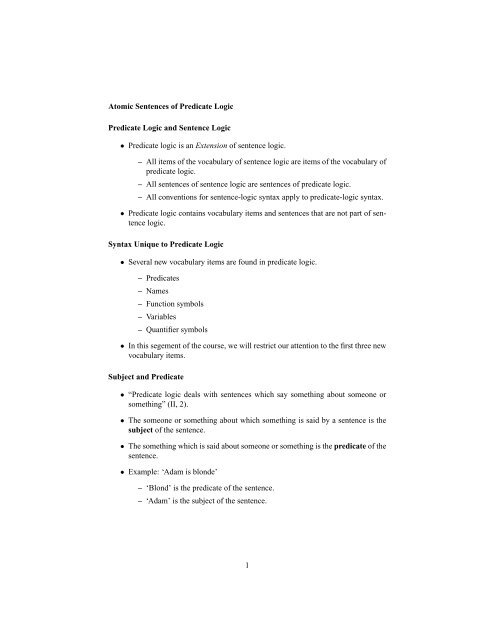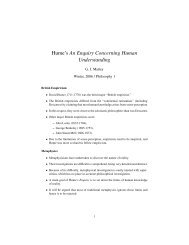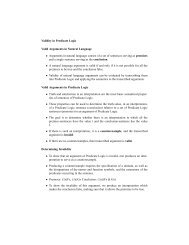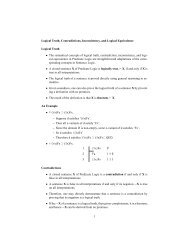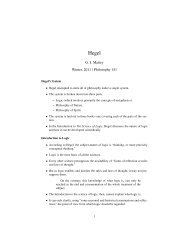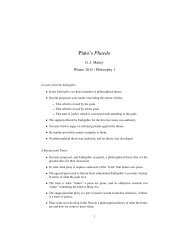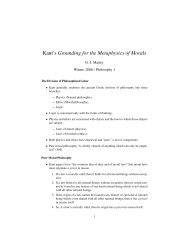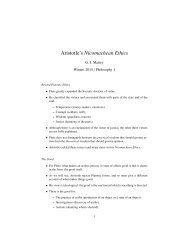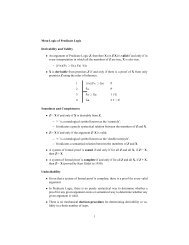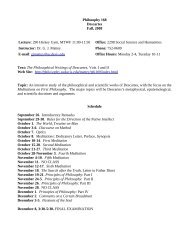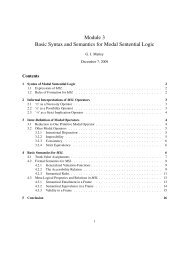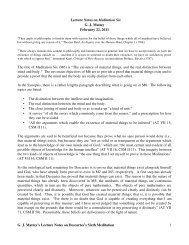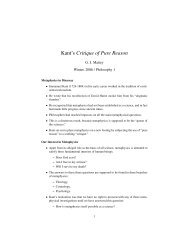Atomic Sentences of Predicate Logic - the UC Davis Philosophy ...
Atomic Sentences of Predicate Logic - the UC Davis Philosophy ...
Atomic Sentences of Predicate Logic - the UC Davis Philosophy ...
You also want an ePaper? Increase the reach of your titles
YUMPU automatically turns print PDFs into web optimized ePapers that Google loves.
<strong>Atomic</strong> <strong>Sentences</strong> <strong>of</strong> <strong>Predicate</strong> <strong>Logic</strong><br />
<strong>Predicate</strong> <strong>Logic</strong> and Sentence <strong>Logic</strong><br />
• <strong>Predicate</strong> logic is an Extension <strong>of</strong> sentence logic.<br />
– All items <strong>of</strong> <strong>the</strong> vocabulary <strong>of</strong> sentence logic are items <strong>of</strong> <strong>the</strong> vocabulary <strong>of</strong><br />
predicate logic.<br />
– All sentences <strong>of</strong> sentence logic are sentences <strong>of</strong> predicate logic.<br />
– All conventions for sentence-logic syntax apply to predicate-logic syntax.<br />
• <strong>Predicate</strong> logic contains vocabulary items and sentences that are not part <strong>of</strong> sentence<br />
logic.<br />
Syntax Unique to <strong>Predicate</strong> <strong>Logic</strong><br />
• Several new vocabulary items are found in predicate logic.<br />
– <strong>Predicate</strong>s<br />
– Names<br />
– Function symbols<br />
– Variables<br />
– Quantifier symbols<br />
• In this segement <strong>of</strong> <strong>the</strong> course, we will restrict our attention to <strong>the</strong> first three new<br />
vocabulary items.<br />
Subject and <strong>Predicate</strong><br />
• “<strong>Predicate</strong> logic deals with sentences which say something about someone or<br />
something” (II, 2).<br />
• The someone or something about which something is said by a sentence is <strong>the</strong><br />
subject <strong>of</strong> <strong>the</strong> sentence.<br />
• The something which is said about someone or something is <strong>the</strong> predicate <strong>of</strong> <strong>the</strong><br />
sentence.<br />
• Example: ‘Adam is blonde’<br />
– ‘Blond’ is <strong>the</strong> predicate <strong>of</strong> <strong>the</strong> sentence.<br />
– ‘Adam’ is <strong>the</strong> subject <strong>of</strong> <strong>the</strong> sentence.<br />
1
Object and Property<br />
• The subject <strong>of</strong> a subject-predicate sentence refers to an object.<br />
– ‘Adam’ refers to <strong>the</strong> person, Adam.<br />
• The predicate <strong>of</strong> a subject-predicate sentence indicates property or a relation.<br />
– ‘Blond’ refers to <strong>the</strong> property being blond.<br />
• The property indicated by <strong>the</strong> predicate is attributed to <strong>the</strong> object referred to by<br />
<strong>the</strong> name.<br />
Relations<br />
<strong>Predicate</strong><br />
Subject<br />
Property Attributed to Object<br />
Being blond Property <strong>of</strong> Adam<br />
• In some sentences, a predicate has multiple subjects.<br />
– ‘Eve loves Adam’.<br />
• Each subject refers to an object.<br />
– ‘Adam’ refers to Adam.<br />
– ‘Eve’ refers to Eve.<br />
• The two-place predicate <strong>of</strong> such a sentence indicates a relation holding between<br />
what <strong>the</strong> subjects refer to.<br />
<strong>Predicate</strong> Subject 1 Subject 2<br />
Relation Holds between Object 1 Object 2<br />
Loving Relation <strong>of</strong> Eve to Adam<br />
Symbolization <strong>of</strong> Subjects and <strong>Predicate</strong>s<br />
• Natural-language predicates are symbolized in <strong>Predicate</strong> <strong>Logic</strong> using upper-case<br />
Roman letters (with or without integer subscripts) which are called <strong>Predicate</strong>s.<br />
– ‘B’ might stand in for <strong>the</strong> one-place English predicate ‘blond’.<br />
– ‘L’ might stand in for <strong>the</strong> two-place English predicate ‘loves’.<br />
• Natural-language subjects are symbolized in <strong>Predicate</strong> logic using lower-case<br />
Roman letters (with or without integer subscripts), which are called Names.<br />
– ‘a’ might stand in for <strong>the</strong> English name ‘Adam’<br />
– ‘e’ might stand in for <strong>the</strong> English name ‘Eve’<br />
• The choice <strong>of</strong> predicates and names <strong>of</strong> <strong>Predicate</strong> logic to stand in for naturallanguage<br />
predicates and names is arbitrary, except that it must be consistent in a<br />
given context.<br />
2
<strong>Atomic</strong> <strong>Sentences</strong> <strong>of</strong> <strong>Predicate</strong> <strong>Logic</strong><br />
• The most basic sentences <strong>of</strong> <strong>Predicate</strong> <strong>Logic</strong> are <strong>Atomic</strong> <strong>Sentences</strong>.<br />
• There are two types <strong>of</strong> atomic sentences.<br />
– An atomic sentence <strong>of</strong> Sentence <strong>Logic</strong>, which is a predicate followed by no<br />
names.<br />
– A predicate followed by any number <strong>of</strong> names (which are called Arguments).<br />
• Examples:<br />
– ‘S’<br />
– ‘Ba’<br />
– ‘Lea’<br />
Interpreting <strong>Atomic</strong> <strong>Sentences</strong><br />
• As merely syntactical entities, atomic sentences <strong>of</strong> <strong>Predicate</strong> <strong>Logic</strong> have no<br />
meaning.<br />
• The assignment <strong>of</strong> meanings to sentences is called “semantics”.<br />
• <strong>Atomic</strong> sentences can be given meaning as with Sentence <strong>Logic</strong>:<br />
Transcriptions<br />
– Stand-ins for (Transcriptions <strong>of</strong>) natural language sentences.<br />
– Having truth-values t or f.<br />
• Transcriptions have two components:<br />
– A Transcription Guide which associates vocabulary <strong>of</strong> <strong>Predicate</strong> <strong>Logic</strong><br />
with natural-language expressions.<br />
– A sentence or sentences <strong>of</strong> <strong>Predicate</strong> <strong>Logic</strong> which is supposed to capture<br />
<strong>the</strong> structure <strong>of</strong> <strong>the</strong> natural-language sentence or sentences, or<br />
– A sentence or sentence in natural language which is supposed to capture<br />
<strong>the</strong> structure <strong>of</strong> <strong>the</strong> <strong>Predicate</strong> <strong>Logic</strong> sentence or sentences.<br />
• The transcription guide itself contains two components:<br />
– An object for every name <strong>of</strong> <strong>Predicate</strong> <strong>Logic</strong> used in <strong>the</strong> transcription.<br />
– A specification <strong>of</strong> <strong>the</strong> predicates <strong>of</strong> <strong>Predicate</strong> <strong>Logic</strong> used in <strong>the</strong> transcription.<br />
3
An Example<br />
• Suppose we want to transcribe <strong>the</strong> sentence ‘Adam is blond, but Eve is not’.<br />
• We choose to let ‘a’ stand for Adam and ‘e’ for Eve.<br />
– a: Adam e: Eve<br />
• We specify a one-place predicate ‘B’ by writing ‘Bx’ (and a two-place predicate<br />
‘L’ by writing ‘Lxy’, etc.) followed by a quasi-English expression signifying a<br />
predicate.<br />
– Bx: x is blond<br />
• The transcription is: ‘Ba & ∼Be’.<br />
Truth-Conditions for <strong>Atomic</strong> <strong>Sentences</strong><br />
• Let us call a “proper” atomic sentence <strong>of</strong> <strong>Predicate</strong> <strong>Logic</strong> one which contains<br />
names and <strong>the</strong>refore is not a sentence <strong>of</strong> Sentence <strong>Logic</strong>.<br />
• We could assign proper atomic sentences truth-values in <strong>the</strong> same way as in<br />
Sentence <strong>Logic</strong>.<br />
• This is done by expanding Sentence-<strong>Logic</strong> “cases” to Minimal Interpretations.<br />
Interpretations <strong>of</strong> <strong>Sentences</strong><br />
• Just as a truth-table only specifies truth-values for <strong>the</strong> sentences that appear in it,<br />
an interpretation in <strong>Predicate</strong> <strong>Logic</strong> may be limited in its scope.<br />
• The range <strong>of</strong> application <strong>of</strong> an interpretation is determined by three sets it contains:<br />
– Sentence Letters<br />
– Names<br />
– <strong>Predicate</strong>s<br />
• If all <strong>the</strong> names, predicates, and sentence-letters occuring in a sentence X occur<br />
in <strong>the</strong> interpretation, <strong>the</strong>n it is an Interpretation <strong>of</strong> <strong>the</strong> Sentence X.<br />
Minimal Interpretations<br />
• The truth-value <strong>of</strong> atomic sentences in an interpretation can be assigned just as<br />
in sentence logic.<br />
• Consider interpretations which contain ‘B’, ‘e’, and ‘a’, and nothing else.<br />
• There are exactly two atomic sentences to which <strong>the</strong> interpretations apply: ‘Ba’<br />
and ‘Be’.<br />
4
• This allows us to list four possible interpretations in <strong>the</strong> guise <strong>of</strong> a truth-table.<br />
State Descriptions<br />
Ba Be<br />
interpretation 1 t t<br />
interpretation 2 t f<br />
interpretation 3 f t<br />
interpretation 4 f f<br />
• Each minimal interpretation just listed can be represented in <strong>the</strong> form <strong>of</strong> a sentence<br />
<strong>of</strong> <strong>Predicate</strong> <strong>Logic</strong>.<br />
• Such a sentence was called a “state description” by Rudolf Carnap.<br />
• A state description is a conjunction <strong>of</strong> negated or unnegated atomic sentences.<br />
Domains<br />
– The sentence is unnegated if <strong>the</strong> interpretation assigns it <strong>the</strong> value true.<br />
– The sentence is negated if <strong>the</strong> interpretation assigns it <strong>the</strong> value false.<br />
Ba Be State Description<br />
interpretation 1 t t Ba & Be<br />
interpretation 2 t f Ba & ∼Be<br />
interpretation 3 f f ∼Ba & Be<br />
interpretation 4 f f ∼Ba & ∼Be<br />
• Minimal interpretations treat proper atomic sentences in <strong>the</strong> same way as atomic<br />
sentences <strong>of</strong> Sentence <strong>Logic</strong>.<br />
• To make <strong>the</strong>m more useful, we need a way to link <strong>the</strong> predicates and names<br />
occurring in <strong>the</strong> sentences with objects in <strong>the</strong> world.<br />
• An interpretation should include “a specification <strong>of</strong> <strong>the</strong> objects <strong>of</strong> which each<br />
predicate is true and <strong>the</strong> objects <strong>of</strong> which each predicate is false”.<br />
• A minimal interpretation says nothing about objects.<br />
• We can make an interpretation more robust by supplementing it with:<br />
– A Domain consisting <strong>of</strong> at least one object.<br />
– An association <strong>of</strong> each name in <strong>the</strong> interpretation with at least one object<br />
in <strong>the</strong> domain.<br />
5
An Example<br />
• Suppose <strong>the</strong> domain <strong>of</strong> an interpretation consists <strong>of</strong> Adam and Eve.<br />
• This can be written as: D = {Adam, Eve}.<br />
• The interpretation might assign Adam to ‘a’ and Eve to ‘e’.<br />
• Suppose fur<strong>the</strong>r that it is <strong>the</strong> case that Adam is blond and Eve is not blond.<br />
• Given our earlier remarks, we might want to say that ‘B’ stands for <strong>the</strong> property<br />
<strong>of</strong> being blond.<br />
• Then, we would conclude that on this interpretation, ‘Ba’ is true and ‘Be’ is false.<br />
Intensional and Extensional Interpretations<br />
• An interpretation that makes predicates stand for properties is called “intensional”.<br />
• Intensional interpretations were studied by Leibniz in <strong>the</strong> eighteenth century.<br />
• Modern logic, however, mostly does not use intensional interpretations.<br />
• Instead, it takes a given predicate to stand for a set <strong>of</strong> objects that have a given<br />
property.<br />
• Such an interpretation is “extensional”.<br />
One-Place <strong>Predicate</strong>s<br />
• Suppose we have interpretations which include <strong>the</strong> predicate ‘B’ and <strong>the</strong> names<br />
‘a’ and ‘e’ and nothing else.<br />
• Consider a class <strong>of</strong> interpretations whose domain is {Adam, Eve}, and where ‘a’<br />
stands for Adam, ‘e’ for Eve.<br />
• There are four possible extensions for ‘B’, and <strong>the</strong>refore four possible interpretations<br />
in this class.<br />
a e B<br />
interpretation 1 Adam Eve Adam, Eve<br />
interpretation 2 Adam Eve Adam<br />
interpretation 3 Adam Eve Eve<br />
interpretation 4 Adam Eve Nobody<br />
6
Determining Truth-Values<br />
• It is easy to see how <strong>the</strong> truth-values <strong>of</strong> ‘Ba’ and ‘Be’ are determined given <strong>the</strong>se<br />
interpretations.<br />
a e B Ba Be<br />
interpretation 1 Adam Eve Adam, Eve t t<br />
interpretation 2 Adam Eve Adam t f<br />
interpretation 3 Adam Eve Eve f t<br />
interpretation 4 Adam Eve Nobody f f<br />
• The truth-condition for atomic sentences with one-place predicates is: if <strong>the</strong> object<br />
designated by <strong>the</strong> name is in <strong>the</strong> extension <strong>of</strong> <strong>the</strong> predicate, <strong>the</strong>n <strong>the</strong> sentence<br />
is true; o<strong>the</strong>rwise, it is false.<br />
Extensions <strong>of</strong> Relation Symbols<br />
• <strong>Predicate</strong>s <strong>of</strong> two-places or more are called “relation symbols”.<br />
• The extensions <strong>of</strong> relation symbols are sets <strong>of</strong> pairs, triples, quadruples, etc.,<br />
depending on <strong>the</strong> number <strong>of</strong> arguments <strong>the</strong> predicate has.<br />
• We represent <strong>the</strong>se n-tuples with angled brackets.<br />
– The pair (2-tuple) consisting <strong>of</strong> Adam and Eve is represented as 〈Adam,<br />
Eve〉.<br />
– The triple (3-tuple) consisting <strong>of</strong> Adam, Eve, and Cid is represented as<br />
〈Adam, Eve, Cid〉.<br />
• Strictly speaking, <strong>the</strong> extension <strong>of</strong> a one-place predicate is a set <strong>of</strong> 1-tuples.<br />
An Example<br />
– The 1-tuple consisting <strong>of</strong> Adam is represented as 〈Adam〉.<br />
• Let an interpretation listing <strong>the</strong> one-place predicate ‘L’ have a domain consisting<br />
<strong>of</strong> Adam and Eve.<br />
• There are four possible items in <strong>the</strong> extension <strong>of</strong> ‘L’:<br />
– 〈Adam, Adam〉<br />
– 〈Adam, Eve〉<br />
– 〈Eve, Adam〉<br />
– 〈Eve, Eve〉<br />
• An interpretation representing <strong>the</strong> case where Adam and Eve love only <strong>the</strong>mselves<br />
would specify <strong>the</strong> extension <strong>of</strong> ‘L’ as consisting <strong>of</strong> 〈Adam, Adam〉 and<br />
〈Eve, Eve〉.<br />
7
General Truth-Condition<br />
• With <strong>the</strong> given interpretation, we can once again see what <strong>the</strong> truth-values <strong>of</strong><br />
various sentences are.<br />
a e L Laa Lae Lea Lee<br />
Adam Eve 〈Adam, Adam〉〈Eve, Eve〉 t f f t<br />
• An atomic sentence with an n-place predicate is true in an interpretation if <strong>the</strong> n-<br />
tuple consisting <strong>of</strong> <strong>the</strong> referents <strong>of</strong> <strong>the</strong> arguments (from left to right) is a member<br />
<strong>of</strong> <strong>the</strong> extension <strong>of</strong> <strong>the</strong> predicate; <strong>the</strong> sentence is false o<strong>the</strong>rwise.<br />
Functions<br />
L a a<br />
↓ ↓<br />
〈Adam, Adam〉<br />
• <strong>Predicate</strong> <strong>Logic</strong> may be enhanced by <strong>the</strong> addition <strong>of</strong> a way <strong>of</strong> forming name-like<br />
expressions: Function Symbols.<br />
• Function symbols consist <strong>of</strong> italicized lower-case Roman letters, followed by a<br />
set <strong>of</strong> paren<strong>the</strong>ses and containing from 0 to n commas, where n is a finite number.<br />
– f ( )<br />
– g( , )<br />
– h( , , )<br />
• Filling <strong>the</strong> spaces in <strong>the</strong> function symbols are ei<strong>the</strong>r names or o<strong>the</strong>r filled-in<br />
function symbols.<br />
– f (a)<br />
– g(f (a),f (b))<br />
– h(g(f (a),g(b),c))<br />
Interpretation <strong>of</strong> Function Symbols<br />
• Function symbols are intended to represent functions.<br />
• We illustrate <strong>the</strong> notion <strong>of</strong> a function by beginning with one-place function symbols,<br />
where what fills <strong>the</strong> blank is a name, for example, f (a).<br />
• In an interpretation, <strong>the</strong> name designates exactly one member <strong>of</strong> <strong>the</strong> domain,<br />
which is an Argument <strong>of</strong> <strong>the</strong> function that <strong>the</strong> function symbol signifies.<br />
• The filled-in function symbol itself designates exactly one member <strong>of</strong> <strong>the</strong> domain<br />
(<strong>the</strong> Value <strong>of</strong> <strong>the</strong> function).<br />
8
An Example<br />
• Consider a domain with two members, Adam and Eve.<br />
• Informally, we might consider ‘f ( )’ to designate <strong>the</strong> spouse function (which<br />
presumes monogamy).<br />
• Adam is <strong>the</strong> spouse <strong>of</strong> Eve, and Eve is <strong>the</strong> spouse <strong>of</strong> Adam.<br />
• So when Adam is <strong>the</strong> argument, Eve is <strong>the</strong> value, and when Eve is <strong>the</strong> argument,<br />
Adam is <strong>the</strong> value.<br />
Applying <strong>the</strong> Example<br />
a e f(a) f(e)<br />
Adam Eve Eve Adam<br />
• The interpretation <strong>of</strong> atomic sentences can be applied to <strong>the</strong> interpretation <strong>of</strong><br />
function symbols.<br />
• Specifically, we can determine values <strong>of</strong> <strong>the</strong> following sentences.<br />
a e f (a) f (e) B Bf (a) Bf (e)<br />
interp. 1 Adam Eve Eve Adam Adam, Eve t t<br />
interp. 2 Adam Eve Eve Adam Adam f t<br />
interp. 3 Adam Eve Eve Adam Eve t f<br />
interp. 4 Adam Eve Eve Adam Nobody f f<br />
Many-Place Functions<br />
• Functions <strong>of</strong> more than one place are treated similarly to functions <strong>of</strong> one place.<br />
• There always a single value, no matter how many arguments <strong>the</strong> function might<br />
have.<br />
• For example, consider a domain which consists <strong>of</strong> <strong>the</strong> positive integers, 1, 2, 3, .<br />
. . .<br />
• An addition function takes any two positive integers as arguments and returns a<br />
single value, <strong>the</strong> sum <strong>of</strong> <strong>the</strong> two numbers.<br />
• If ‘a’ designates 1, designates ‘b’ 2, and f ( , ) designates <strong>the</strong> addition function,<br />
<strong>the</strong>n ‘f (a,b)’ designates 3.<br />
9
Values <strong>of</strong> Functions as Arguments <strong>of</strong> Functions<br />
• Since <strong>the</strong> value <strong>of</strong> a function is an object in <strong>the</strong> domain, it can serve as <strong>the</strong><br />
argument <strong>of</strong> a function (even <strong>the</strong> same one).<br />
• A natural example is <strong>the</strong> application <strong>of</strong> <strong>the</strong> addition function to <strong>the</strong> result <strong>of</strong><br />
addition.<br />
– (1 + 2) + 1<br />
• If we use <strong>the</strong> interpretations just given, we can represent this as: f (f (a,b),a).<br />
• ‘f (a,b)’ represents <strong>the</strong> number 3, so ‘f (f (a,b),a)’ represents <strong>the</strong> result <strong>of</strong> <strong>the</strong> addition<br />
<strong>of</strong> 3 and 1, i.e., 4.<br />
Constant Terms<br />
• We shall call a name a Constant or Constant Term.<br />
• A function symbol which is filled in by names is also a constant term.<br />
• More generally, a function symbol which is filled in by constant terms is also a<br />
constant term.<br />
• Nothing else is a constant term.<br />
The Identity <strong>Predicate</strong><br />
• A special two-place predicate is <strong>the</strong> Identity predicate ‘=’.<br />
• By convention, <strong>the</strong> identity predicate is placed between two constant terms,<br />
ra<strong>the</strong>r than in front <strong>of</strong> <strong>the</strong>m.<br />
– a = b<br />
– f (a) = g(f (b),f (c))<br />
• The identity predicate is always interpreted in <strong>the</strong> same way.<br />
• If both constant terms designate <strong>the</strong> same member <strong>of</strong> <strong>the</strong> domain, <strong>the</strong> identity<br />
sentence containing <strong>the</strong>m is true; o<strong>the</strong>rwise, it is false.<br />
An Example<br />
• In <strong>the</strong> following example, we look at four interpretations that differ in <strong>the</strong> function<br />
designated by <strong>the</strong> function symbol ‘f ( )’.<br />
a e f (a) f (e) a = e a = f (e) f (e) = f (a)<br />
i. 1 Adam Eve Adam Adam f t t<br />
i. 2 Adam Eve Adam Eve f f f<br />
i. 3 Adam Eve Eve Adam f t f<br />
i. 4 Adam Eve Eve Eve f f t<br />
10
Metavariables for <strong>Atomic</strong> <strong>Sentences</strong><br />
• The metavariables ‘s’ and ‘t’ designate any constant terms (name or filled-in<br />
function symbol).<br />
• Note that in <strong>the</strong> text, ‘s’ and ‘t’ are restricted to designating names.<br />
• The metavariables ‘P( )’, ‘Q( )’, and ‘R( )’ indicate sentences <strong>of</strong> <strong>Predicate</strong> <strong>Logic</strong><br />
containing terms.<br />
• ‘P(s)’ indicates a sentence <strong>of</strong> <strong>Predicate</strong> <strong>Logic</strong> containing <strong>the</strong> term designated by<br />
‘s’, and ‘P(t)’ indicates a sentence containing <strong>the</strong> term designated by ‘t’.<br />
– If ‘s’ indicates <strong>the</strong> constant ‘a’, <strong>the</strong>n ‘Lea’ can be represented as ‘P(s)’.<br />
• ‘P(t/s)’ indicates <strong>the</strong> result <strong>of</strong> substituting t in all <strong>the</strong> places where s occurs.<br />
Introduction Rule for <strong>the</strong> Identity <strong>Predicate</strong><br />
• Identity Introduction (=I): t = t may be written on any line <strong>of</strong> a derivation.<br />
• The rule is truth-preserving because <strong>the</strong> designation <strong>of</strong> any constant term is fixed<br />
by <strong>the</strong> interpretation, so that <strong>the</strong> designation <strong>of</strong> t is always <strong>the</strong> same, in which<br />
case 〈<strong>the</strong> designation <strong>of</strong> t, <strong>the</strong> designation <strong>of</strong> t〉 is in <strong>the</strong> extension <strong>of</strong> ‘=’, no<br />
matter what t designates.<br />
Elimination Rule for <strong>the</strong> Identity <strong>Predicate</strong><br />
• Identity Elimination (=E): when s = t occurs on an accessible earlier line, <strong>the</strong>n<br />
given P(s), it follows that P(t/s).<br />
– a = b Lae Lbe<br />
– a = b Lbe Lae<br />
• The rule is truth-preserving because <strong>the</strong> truth <strong>of</strong> s = t requires that s and t designate<br />
<strong>the</strong> same individual, and by <strong>the</strong> semantics, anything holding <strong>of</strong> what s<br />
designates holds <strong>of</strong> what t designates.<br />
Summary<br />
• The subject <strong>of</strong> a subject-predicate English sentence is represented in a transcribed<br />
<strong>Predicate</strong> <strong>Logic</strong> sentence by a constant term <strong>of</strong> <strong>Predicate</strong> <strong>Logic</strong>, whose<br />
designation is determined ny <strong>the</strong> interpretation <strong>of</strong> <strong>the</strong> sentence.<br />
– A name<br />
– A filled-in function symbol<br />
• The predicate <strong>of</strong> a subject-predicate English sentence is represented in a transcribed<br />
<strong>Predicate</strong> <strong>Logic</strong> sentence by a predicate <strong>of</strong> <strong>Predicate</strong> <strong>Logic</strong>.<br />
11
– An n-place predicate whose extension is determined by <strong>the</strong> interpretation.<br />
– A two-place identity predicate ‘=’ whose extension is <strong>the</strong> same on any interpretation.<br />
• An atomic sentence <strong>of</strong> <strong>Predicate</strong> <strong>Logic</strong> consists <strong>of</strong> an n-place predicate followed<br />
by n constant terms.<br />
Objectual Semantics<br />
• The semantics that has been introduced here is sometimes called “objectual”.<br />
• The original semantics for <strong>Predicate</strong> <strong>Logic</strong> due to Alfred Tarski is objectual in<br />
character.<br />
• The semantics is called objectual because <strong>the</strong> truth-conditions for atomic sentences<br />
are based on <strong>the</strong> designation <strong>of</strong> objects in <strong>the</strong> domain by constant terms<br />
and on <strong>the</strong> objects or ordered n-tuples <strong>of</strong> objects in <strong>the</strong> extensions <strong>of</strong> predicates.<br />
Presentation <strong>of</strong> <strong>the</strong> Domain<br />
• The formulation <strong>of</strong> interpretations in Exercises 2-1 and 2-2 differs from that in<br />
2-5, with <strong>the</strong> latter being closer <strong>the</strong> <strong>the</strong> formulation presented here.<br />
• In <strong>the</strong> earlier exercises, <strong>the</strong> domain is specified using <strong>the</strong> names given it by <strong>the</strong><br />
interpretation<br />
– D = {b,d}.<br />
• “In practice, we <strong>of</strong>ten specify <strong>the</strong> domain <strong>of</strong> an interpretation simply by giving<br />
<strong>the</strong> interpretation’s name for those objects” (II, 16).<br />
• In <strong>the</strong> 2-5 exercises, <strong>the</strong> domain is specified directly,<br />
– All integers, 1, 2, 3, 4, . . . .<br />
Determining Truth-Values<br />
• The specification <strong>of</strong> “which one place predicates apply to which individual objects,<br />
which two place predicates apply to which pairs <strong>of</strong> object, and so on” is<br />
presented in <strong>the</strong> earlier exercises through a state description.<br />
• A state description summarizes <strong>the</strong> result <strong>of</strong> <strong>the</strong> atomic sentences’ getting a truthvalue.<br />
– ∼Tb & Td & Kbb & ∼Kbd & ∼Kdb & Kdd.<br />
• The application <strong>of</strong> predicates to objects is left to <strong>the</strong> general knowledge <strong>of</strong> <strong>the</strong><br />
reader.<br />
– That 1 is odd, or that not all integers are greater than 17.<br />
12
Tarski Semantics<br />
• We have developed semantics for atomic sentences in <strong>the</strong> style <strong>of</strong> Tarski.<br />
• This style most closely resembles <strong>the</strong> later exercises.<br />
• The Tarski-style semantics makes an explicit assignment <strong>of</strong> members <strong>of</strong> <strong>the</strong> domain<br />
to names.<br />
– The domain is {Betty, Dylan}, with ‘b’ designating Betty, and ‘d’ designating<br />
Dylan.<br />
• The extensions <strong>of</strong> predicates <strong>of</strong> <strong>Predicate</strong> <strong>Logic</strong>, and <strong>the</strong> meanings <strong>of</strong> function<br />
symbols are given.<br />
– The extension <strong>of</strong> ‘T’ is {〈Dylan〉}<br />
• From this we can determine truth-values.<br />
– Betty is not in <strong>the</strong> extension <strong>of</strong> ‘T’, so ‘Tb’ is false, and ‘∼Tb’ is true.<br />
From State Descriptions to Explicit Intepretations<br />
• The state-description presentation <strong>of</strong> <strong>the</strong> semantics requires that an interpretation<br />
have a domain, which is specified by names <strong>of</strong> <strong>Predicate</strong> <strong>Logic</strong>.<br />
• If we specify <strong>the</strong> domain in this way, we have not said what <strong>the</strong> items in <strong>the</strong><br />
domain are, unless we associate <strong>the</strong> <strong>Predicate</strong> <strong>Logic</strong> names with natural-language<br />
names (as in a transcription guide).<br />
– D = {b,d}, b: Betty, d: Dylan.<br />
• State descriptions, along with <strong>the</strong> transcription guide, can be used to determine<br />
which n-tuples <strong>of</strong> objects are in <strong>the</strong> extensions <strong>of</strong> which predicates.<br />
• ‘∼Tb’ indicates that <strong>the</strong> one-tuple <strong>of</strong> <strong>the</strong> object in <strong>the</strong> domain designated by ‘b’<br />
(Betty) is not in <strong>the</strong> extension <strong>of</strong> ‘T’.<br />
13


